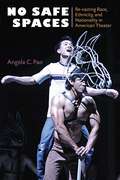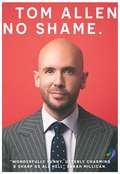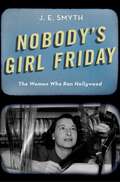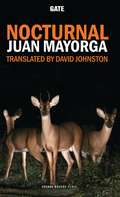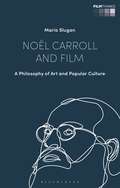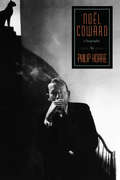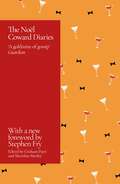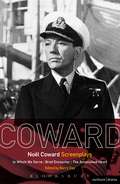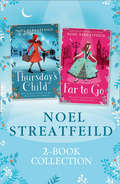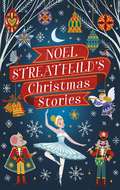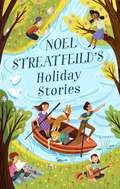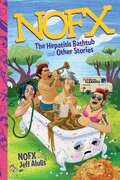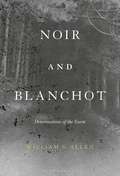- Table View
- List View
No Room for Secrets
by Joanna LumleyPatsy Stone in Absolutely Fabulous; Purdey in The New Avengers; Bond Girl in On Her Majesty's Secret Service; Sapphire in Sapphire and Steel; a castaway in Girl Friday; actress; model; writer; campaigner; inventor; TV presenter and journalist: Joanna Lumley has played many roles in her lifetime, but rarely had the opportunity to reveal her true self.Intimate, funny, intriguing and moving, No Room for Secrets is a more surprising and revealing autobiography than any sensational 'kiss and tell' memoir you will ever read. Inside you will find the real Joanna Lumley.
No Safe Spaces: Re-casting Race, Ethnicity, and Nationality in American Theater (Theater: Theory/Text/Performance)
by Angela C Pao"No Safe Spaces opens up a conversation beyond narrow polemics . . . Although cross-racial casting has been the topic of heated discussion, little sustained scholarship addresses both the historical precedents and theoretical dimensions. Pao illustrates the tensions and contradictions inherent not only in stage representations, but also in the performance of race in everyday life. A wonderful book whose potential readership goes well beyond theater and performance scholars." ---Josephine Lee, University of Minnesota "Non-traditional casting, increasingly practiced in American theater, is both deeply connected to our country's racial self-image(s) and woefully under-theorized. Pao takes on the practice in its entirety to disentangle the various strands of this vitally important issue." ---Karen Shimakawa, New York University No Safe Spaces looks at one of the most radical and enduring changes introduced during the Civil Rights era---multiracial and cross-racial casting practices in American theater. The move to cast Latino/a, African American, and Asian American actors in classic stage works by and about white Europeans and Americans is viewed as both social and political gesture and artistic innovation. Nontraditionally cast productions are shown to have participated in the national dialogue about race relations and ethnic identity and served as a source of renewed creativity for the staging of the canonical repertory. Multiracial casting is explored first through its history, then through its artistic, political, and pragmatic dimensions. Next, the book focuses on case studies from the dominant genres of contemporary American theater: classical tragedy and comedy, modern domestic drama, antirealist drama, and the Broadway musical, using a broad array of archival source materials to enhance and illuminate its arguments. Angela C. Pao is Associate Professor of Comparative Literature at Indiana University. A volume in the series Theater: Theory/Text/Performance
No Shame: the hilarious and candid memoir from one of our best-loved comedians
by Tom Allen'Wonderfully funny, utterly charming and sharp as all Hell' SARAH MILLICAN'Tom Allen is one of the funniest comedians in the UK, the best dressed man I know and now it turns out he is a superb writer. I hate him'JOSH WIDDICOMBE'A delightful, touching side-splitter'JO BRAND'An absolute joy! Funny, witty and totally charming'ALAN CARR~~~~~'When I was 16 I dressed in Victorian clothing in a bid to distract people from the fact that I was gay. It was a flawed plan.'No Shame is a very funny, candid and emotional ride of a memoir by one of our most beloved comedians. The working-class son of a coach driver, and the youngest member of the Noel Coward Society, Tom Allen grew up in 90s suburbia as the eternal outsider.In these hilarious, honest and heart breaking stories Tom recalls observations on childhood, his adolescence, the family he still lives with, and his attempts to come out and negotiate the gay dating scene. They are written with his trademark caustic wit and warmth, and will entertain, surprise and move you in equal measure.
No Tears for the Clown: An Autobiography
by Les DawsonLes Dawson's autobiography reveals the personal dramas in his life which were to have a profound effect on his life both on and off stage, and recalls the funnier moments that helped him through.
No Time Like the Future: An Optimist Considers Mortality
by Michael J FoxThe entire world knows Michael J. Fox as Marty McFly, the teenage sidekick of Doc Brown in Back to the Future. His two previous bestselling memoirs, Lucky Man and Always Looking Up, dealt with how he came to terms with the illness, all the while exhibiting his iconic optimism. In No Time Like the Future: An Optimist Considers Mortality, Michael shares personal stories and observations about illness and health, ageing, the strength of family and friends, and how our perceptions about time affect the way we approach mortality. Thoughtful and moving, but with Fox's trademark sense of humour, his book provides a vehicle for reflection about our lives, our loves, and our losses.Running through the narrative is the drama of the medical madness Fox recently experienced, that included his daily negotiations with the Parkinson's disease he's had since 1991, and a spinal cord issue that necessitated immediate surgery. His challenge to learn how to walk again, only to suffer a devastating fall, nearly caused him to ditch his trademark optimism and "get out of the lemonade business altogether."Does he make it all of the way back? Read the book.
Noah as Antihero: Darren Aronofsky’s Cinematic Deluge (Routledge Studies in Religion and Film)
by Rhonda Burnette-Bletsch Jon MorganThis collection of essays by biblical scholars is the first book-length treatment of the 2014 film Noah, directed by Darren Aronofsky. The film has proved to be of great interest to scholars working on the interface between the Bible and popular culture, not only because it was heralded as the first of a new generation of biblical blockbusters, but also because of its bold, provocative, and yet unusually nuanced approach to the interpretation and use of the Noah tradition, in both its biblical and extra-biblical forms. The book’s chapters, written by both well-established and up-and-coming scholars, engage with and analyze a broad range of issues raised by the film, including: its employment and interpretation of the ancient Noah traditions; its engagement with contemporary environmental themes and representation of non-human animals; its place within the history of cinematic depictions of the flood, status as an ‘epic’, and associated relationship to spectacle; the theological implications of its representation of a hidden and silent Creator and responses to perceived revelation; the controversies surrounding its reception among religious audiences, especially in the Muslim world; and the nature and implications of its convoluted racial and gender politics. Noah as Antihero will be of considerable interest to scholars conducting research in the areas of religion and film, contemporary hermeneutics, reception history, religion and popular culture, feminist criticism, and ecological ethics.
Noah as Antihero: Darren Aronofsky’s Cinematic Deluge (Routledge Studies in Religion and Film)
by Rhonda Burnette-Bletsch Jon MorganThis collection of essays by biblical scholars is the first book-length treatment of the 2014 film Noah, directed by Darren Aronofsky. The film has proved to be of great interest to scholars working on the interface between the Bible and popular culture, not only because it was heralded as the first of a new generation of biblical blockbusters, but also because of its bold, provocative, and yet unusually nuanced approach to the interpretation and use of the Noah tradition, in both its biblical and extra-biblical forms. The book’s chapters, written by both well-established and up-and-coming scholars, engage with and analyze a broad range of issues raised by the film, including: its employment and interpretation of the ancient Noah traditions; its engagement with contemporary environmental themes and representation of non-human animals; its place within the history of cinematic depictions of the flood, status as an ‘epic’, and associated relationship to spectacle; the theological implications of its representation of a hidden and silent Creator and responses to perceived revelation; the controversies surrounding its reception among religious audiences, especially in the Muslim world; and the nature and implications of its convoluted racial and gender politics. Noah as Antihero will be of considerable interest to scholars conducting research in the areas of religion and film, contemporary hermeneutics, reception history, religion and popular culture, feminist criticism, and ecological ethics.
Nobody's Girl Friday: The Women Who Ran Hollywood
by J. E. SmythLooking back on her career in 1977, Bette Davis remembered with pride, "Women owned Hollywood for twenty years." She had a point. Between 1930 and 1950, over 40% of film industry employees were women, 25% of all screenwriters were female, one woman ran MGM behind the scenes, over a dozen women worked as producers, a woman headed the Screen Writers Guild three times, and press claimed Hollywood was a generation or two ahead of the rest of the country in terms of gender equality and employment. The first comprehensive history of Hollywood's high-flying career women during the studio era, Nobody's Girl Friday covers the impact of the executives, producers, editors, writers, agents, designers, directors, and actresses who shaped Hollywood film production and style, led their unions, climbed to the top during the war, and fought the blacklist. Based on a decade of archival research, author J.E. Smyth uncovers a formidable generation working within the American film industry and brings their voices back into the history of Hollywood. Their achievements, struggles, and perspectives fundamentally challenge popular ideas about director-based auteurism, male dominance, and female disempowerment in the years between First and Second Wave Feminism. Nobody's Girl Friday is a revisionist history, but it's also a deeply personal, collective account of hundreds of working women, the studios they worked for, and the films they helped to make. For many years, historians and critics have insisted that both American feminism and the power of women in Hollywood declined and virtually disappeared from the 1920s through the 1960s. But Smyth vindicates Bette Davis's claim. The story of the women who called the shots in studio-era Hollywood has never fully been told-until now.
Nobody's Girl Friday: The Women Who Ran Hollywood
by J. E. SmythLooking back on her career in 1977, Bette Davis remembered with pride, "Women owned Hollywood for twenty years." She had a point. Between 1930 and 1950, over 40% of film industry employees were women, 25% of all screenwriters were female, one woman ran MGM behind the scenes, over a dozen women worked as producers, a woman headed the Screen Writers Guild three times, and press claimed Hollywood was a generation or two ahead of the rest of the country in terms of gender equality and employment. The first comprehensive history of Hollywood's high-flying career women during the studio era, Nobody's Girl Friday covers the impact of the executives, producers, editors, writers, agents, designers, directors, and actresses who shaped Hollywood film production and style, led their unions, climbed to the top during the war, and fought the blacklist. Based on a decade of archival research, author J.E. Smyth uncovers a formidable generation working within the American film industry and brings their voices back into the history of Hollywood. Their achievements, struggles, and perspectives fundamentally challenge popular ideas about director-based auteurism, male dominance, and female disempowerment in the years between First and Second Wave Feminism. Nobody's Girl Friday is a revisionist history, but it's also a deeply personal, collective account of hundreds of working women, the studios they worked for, and the films they helped to make. For many years, historians and critics have insisted that both American feminism and the power of women in Hollywood declined and virtually disappeared from the 1920s through the 1960s. But Smyth vindicates Bette Davis's claim. The story of the women who called the shots in studio-era Hollywood has never fully been told-until now.
Nocturnal (Oberon Modern Plays)
by David Johnston Juan MayorgaWhen you're alone in a big city, how far would you go to make a new friend?Two men live in the same apartment block. One likes long walks, Greek myths and foreign languages. The other likes making lists, fixing bikes and blackmail. One day they bump into each other in a local café. Only this is no coincidence: one of them has been planning this moment for a very, very, very long time.A brilliant new satire about obsession, insomnia and ships that pass in the night, this new translation of Nocturnal premiered at Gate Theatre in April 200
Noël Carroll and Film: A Philosophy of Art and Popular Culture (Film Thinks)
by Mario SluganNoel Carroll is one of the most prolific, widely-cited and distinguished philosophers of art, but how, specifically, has cinema impacted his thought? This book, one of the first in the acclaimed 'Film Thinks' series, argues that Carroll's background in both cinema and philosophy has been crucial to his overall theory of aesthetics. Often a controversial figure within film studies, as someone who has assertively contested the psychoanalytic, semiotic and Marxist cornerstones of the field, his allegiance to alternative philosophical traditions has similarly polarised his readership.Mario Slugan proposes that Carroll's defence of the notions of truth and objectivity provides a welcome antidote to 'anything goes' attitudes and postmodern scepticism towards art and popular culture, including film. Carroll's thinking has loosened the grip of continental philosophers on cinema studies - from Maurice Merleau-Ponty to Gilles Deleuze and Jacques Lacan - by turning to cognitive and analytical approaches. Slugan goes further to reveal that Carroll's methods of evaluation and interpretation in fact, usefully bridge gaps between these `opposing' sides, to look at artworks anew. Throughout, Slugan revisits and enriches Carroll's definitions of popular art, mass art, horror, humour and other topics and concludes by tracing their origins to this important thinker's relationship with the medium of cinema.
Noël Carroll and Film: A Philosophy of Art and Popular Culture (Film Thinks)
by Mario SluganNoel Carroll is one of the most prolific, widely-cited and distinguished philosophers of art, but how, specifically, has cinema impacted his thought? This book, one of the first in the acclaimed 'Film Thinks' series, argues that Carroll's background in both cinema and philosophy has been crucial to his overall theory of aesthetics. Often a controversial figure within film studies, as someone who has assertively contested the psychoanalytic, semiotic and Marxist cornerstones of the field, his allegiance to alternative philosophical traditions has similarly polarised his readership.Mario Slugan proposes that Carroll's defence of the notions of truth and objectivity provides a welcome antidote to 'anything goes' attitudes and postmodern scepticism towards art and popular culture, including film. Carroll's thinking has loosened the grip of continental philosophers on cinema studies - from Maurice Merleau-Ponty to Gilles Deleuze and Jacques Lacan - by turning to cognitive and analytical approaches. Slugan goes further to reveal that Carroll's methods of evaluation and interpretation in fact, usefully bridge gaps between these `opposing' sides, to look at artworks anew. Throughout, Slugan revisits and enriches Carroll's definitions of popular art, mass art, horror, humour and other topics and concludes by tracing their origins to this important thinker's relationship with the medium of cinema.
Noel Coward: A Biography
by Philip HoareTo several generations, actor, playwright, songwriter, and filmmaker, Noël Coward (1899-1973) was the very personification of wit, glamour, and elegance. His biographer, Philip Hoare, given unprecedented access to the private papers and correspondence of Coward family members, compatriots, and numerous lovers, has produced the definitive biography of one of the twentieth century's most celebrated and controversial figures. "Philip Hoare's careful research and lucid presentation in his Noël Coward: A Biography adds depth to the picture."-New York Times Book Review "A fascinating, in-depth biography."—Library Journal "Hoare has profiled vividly and in-depth a complex legend who had a talent for creating and recreating both himself and his works."—Publishers Weekly "In the thicket of books about the life and work of Coward, Philip Hoare's stands out as the most well-documented and objective."—Los Angeles Times "[Hoare's] book, like its subject, strives for effortless sophistication, and succeeds."—Newsday "Hoare's retelling of Coward's story [is] the most vivid, insightful, and fascinating so far."—John Lahr, The New Yorker
The Noel Coward Diaries: With a Foreword by Stephen Fry
by Sheridan Morley Graham Payn'A gold mine of gossip with a cast of thousands' GUARDIANThe unexpurgated diaries of one of the greatest, most talented, and wittily flamboyant characters of the 20th century - with a new introduction by Stephen Fry'Compulsive reading' SUNDAY TIMES'19th February 1956. A A Milne has died. Lord Beaverbrook has not ... Larry is going to make a movie of The Sleeping Prince with Marilyn Monroe, which might conceivably drive him round the bend''28th February 1960 Princess Margaret has announced her engagement to Tony Armstrong-Jones ... He looks quite pretty, but whether or not the marriage is entirely suitable remains to be seen.'Noel Coward was a renowned actor, dramatist, director - and star. His incredible zest, versatility and unrivalled wit are revealed in these diaries, with a cast of characters ranging from The Beatles to the Queen, Churchill to Marilyn Monroe.Touching, funny and revealing, THE NOEL COWARD DIARIES is a superb account of one of the greatest entertainers of all time.
Noel Coward In His Own Words
by Noël Coward'In my time I have said some noteworthy and exceptionally memorable things' Noël Coward.A delightful and revealing collection of quotations from the masterwordsmith, Noël Coward. In his plays, verse, song lyrics, storiesand everyday life, he chose his words to uniquely stylish and truthfuleffect.This insightful portrait includes not only his best-loved witticisms, bons mots andlyrics but also excerpts from his private papers and hidden gems fromunpublished material. Barry Day delves into the whole range of Coward'stalents, as well as his thoughts on theatre, England, the Arts,religion, life and the man himself. In His Own Words displays the usual frivolity, and a surprising capacity for depth and compassion.
Noel Coward In His Own Words
by Noël Coward Barry Day'In my time I have said some noteworthy and exceptionally memorable things' Noël Coward.A delightful and revealing collection of quotations from the masterwordsmith, Noël Coward. In his plays, verse, song lyrics, storiesand everyday life, he chose his words to uniquely stylish and truthfuleffect.This insightful portrait includes not only his best-loved witticisms, bons mots andlyrics but also excerpts from his private papers and hidden gems fromunpublished material. Barry Day delves into the whole range of Coward'stalents, as well as his thoughts on theatre, England, the Arts,religion, life and the man himself. In His Own Words displays the usual frivolity, and a surprising capacity for depth and compassion.
Noël Coward Screenplays: In Which We Serve, Brief Encounter, The Astonished Heart
by Noël Coward Barry DayThis collection brings together three of Coward's most important screenplays – In Which We Serve (1942), Brief Encounter (1945) and The Astonished Heart (1950). The collection features the shooting scripts for each film alongside contextual notes for each play, and a general introduction, by Barry Day. In Which We Serve earned Coward an Academy Honorary Award in 1943 as well as the New York Film Critics Circle Award for Best Film. The film remains a classic of wartime British cinema. Brief Encounter, the most famous screenplay in this collection, is based on Coward's 1936 one-act play Still Life. It remains one of the greatest love stories of all time, coming second in a British Film Institute poll of the top 100 British films. The Astonished Heart tells the story of a psychiatrist's growing obsession for a good-time girl and the resulting tragedy this leads to. This collection features a foreword by Laurence Kardish, Senior Curator Emeritus, Film, at New York's MoMA, and an eight-page black and white plate section of production stills.
Noël Coward Screenplays: In Which We Serve, Brief Encounter, The Astonished Heart
by Noël Coward Barry DayThis collection brings together three of Coward's most important screenplays – In Which We Serve (1942), Brief Encounter (1945) and The Astonished Heart (1950). The collection features the shooting scripts for each film alongside contextual notes for each play, and a general introduction, by Barry Day. In Which We Serve earned Coward an Academy Honorary Award in 1943 as well as the New York Film Critics Circle Award for Best Film. The film remains a classic of wartime British cinema. Brief Encounter, the most famous screenplay in this collection, is based on Coward's 1936 one-act play Still Life. It remains one of the greatest love stories of all time, coming second in a British Film Institute poll of the top 100 British films. The Astonished Heart tells the story of a psychiatrist's growing obsession for a good-time girl and the resulting tragedy this leads to. This collection features a foreword by Laurence Kardish, Senior Curator Emeritus, Film, at New York's MoMA, and an eight-page black and white plate section of production stills.
Noel Streatfeild 2-book Collection: Thursday's Child And Far To Go
by Noel StreatfeildJoin the unforgettable heroine Margaret Thursday as she makes her way from an orphanage to the stage in this ebook collection containing the classic novels Thursday’s Child and Far to Go by Noel Streatfeild, the beloved author of Ballet Shoes.
Noel Streatfeild's Christmas Stories (Virago Modern Classics #759)
by Noel StreatfeildFrom the author of Ballet ShoesIn this captivating collection of festive stories, there are auditions on stage and antics on ice, trips to the pantomime, holiday adventures, and laughter shared with family and friends. Charming, heartwarming and funny, this exciting new collection will bring joy to readers of all ages.Originally written for annuals, magazines and the radio from the 1940s-60s, these stories by this much-loved author have never been collected before and will be a welcome discovery to all Streatfeild's admirers.Stories include:The AuditionThe Bells Keep Twelfth NightThe Moss RoseThimbleThe PrincessThe ChainChristmas at CollersThe Pantomime GooseSkating to the Stars
Noel Streatfeild’s Holiday Stories: By the author of 'Ballet Shoes' (Virago Modern Classics #780)
by Noel StreatfeildA NEW COLLECTION OF HOLIDAY STORIES BY THE BELOVED AUTHOR OF BALLET SHOES. PERFECT READING FOR LONG SUMMER DAYS.In this captivating new collection, there are stories for every reader to enjoy: unforgettable holidays and unlikely friendships, crime-solving adventures and dancers in the spotlight for the very first time. Originally written for annuals and magazines from the 1930s-70s, these newly discovered stories will be treasured by Noel Streatfeild fans of all ages.Featuring beautiful illustrations by PETER BAILEYStories include: The Plain One Devon MettleChicken for SupperFlag's CircusThe SecretCoralieOrdinary Me Cows Eat FlowersAndrew's TroutThe Old FoolLet's Go CoachingHowardThe Quiet HolidayRobertaGreen Silk
NOFX: The Hepatitis Bathtub and Other Stories
by NOFX Jeff AlulisThe candid, hilarious, shocking, occasionally horrifying, and surprisingly moving New York Times bestselling autobiography of punk legends NOFX, their own story in their own wordsNOFX: The Hepatitis Bathtub and Other Stories is the first tell-all autobiography from one of the world's most influential and controversial punk bands. Alongside hilarious anecdotes about pranks and drunkenness and teenage failures-featuring the trademark NOFX sense of humor-the book also shares the ugliness and horror the band members experienced on the road to becoming DIY millionaires. Fans and non-fans alike will be shocked by stories of murder, suicide, addiction, counterfeiting, riots, bondage, terminal illness, the Yakuza, and pee...lots and lots of pee. Told by each of the band members (and two former members), NOFX looks back at more than thirty years of comedy, tragedy, and completely inexplicable success.
Noir and Blanchot: Deteriorations of the Event
by William S. AllenIn dark or desperate times, the artwork is placed in a difficult position. Optimism seems naïve, while pessimism is no better. During some of the most demanding years of the 20th century two distinctive bodies of work sought to respond to this problem: the writings of Maurice Blanchot and American film noir. Both were seeking not only to respond to the times but also to critically reflect them, but both were often criticised for their own darkness. Understanding how this darkness became the means of responding to the darkness of the times is the focus of Noir and Blanchot, which examines key films from the period (including Double Indemnity and Vertigo) alongside Blanchot's writings (particularly his 1948 narrative Death Sentence). What emerges from this investigation is the complex manner in which these works disrupt the experience of time and the event and in doing so expose an entirely different mode of material expression.
Noir and Blanchot: Deteriorations of the Event
by William S. AllenIn dark or desperate times, the artwork is placed in a difficult position. Optimism seems naïve, while pessimism is no better. During some of the most demanding years of the 20th century two distinctive bodies of work sought to respond to this problem: the writings of Maurice Blanchot and American film noir. Both were seeking not only to respond to the times but also to critically reflect them, but both were often criticised for their own darkness. Understanding how this darkness became the means of responding to the darkness of the times is the focus of Noir and Blanchot, which examines key films from the period (including Double Indemnity and Vertigo) alongside Blanchot's writings (particularly his 1948 narrative Death Sentence). What emerges from this investigation is the complex manner in which these works disrupt the experience of time and the event and in doing so expose an entirely different mode of material expression.
Noir, Now and Then: Film Noir Originals and Remakes (1944-1999) (Contributions to the Study of Popular Culture)
by Ronald SchwartzThis examniation of the cinematic style of film noir originals and their neo-noir remakes compares thirty-five films, beginning with Billy Wilder's classic Double Indemnity and concluding with Jim McBride's Breathless. In-depth analysis of the films explain the qualities and characteristics of film noir, while providing critical readings of both the originals and the remakes. The most significant films since 1944 are reviewed and reveal the ever-changing values in American society. As this study reveals, the noir style significantly impacted American film and neo-noir remakes attest to its continued popularity in cinematic art.This work will appeal to film scholars and to fans of film noir. Filmogrpahies and video information follow each chapter. Appendices briefly explain the roots of many noir films discussed in the text along with their subsequent remakes.

